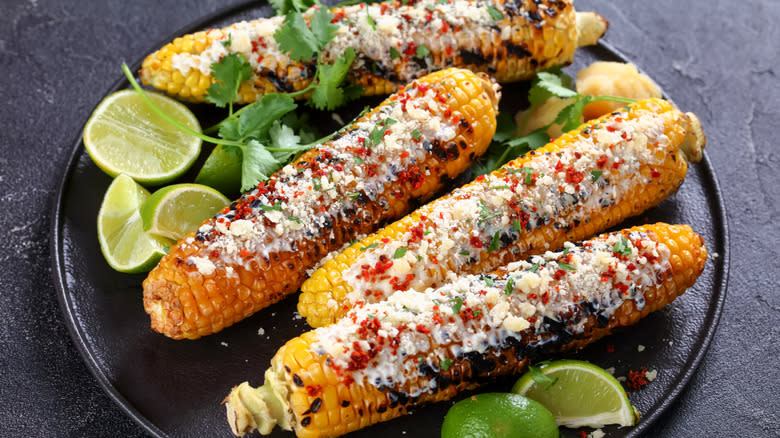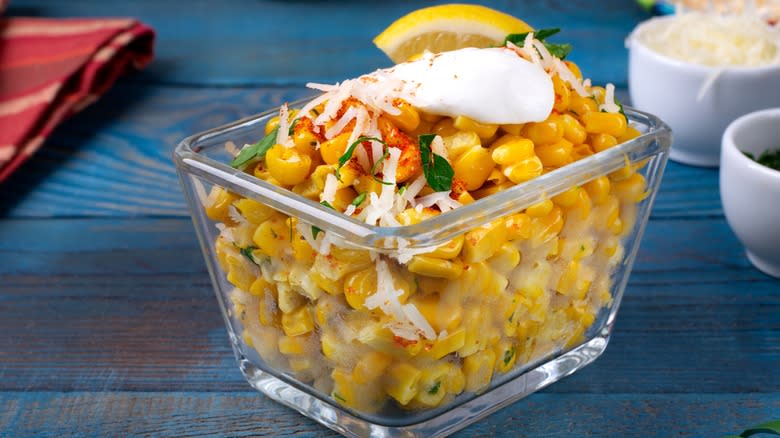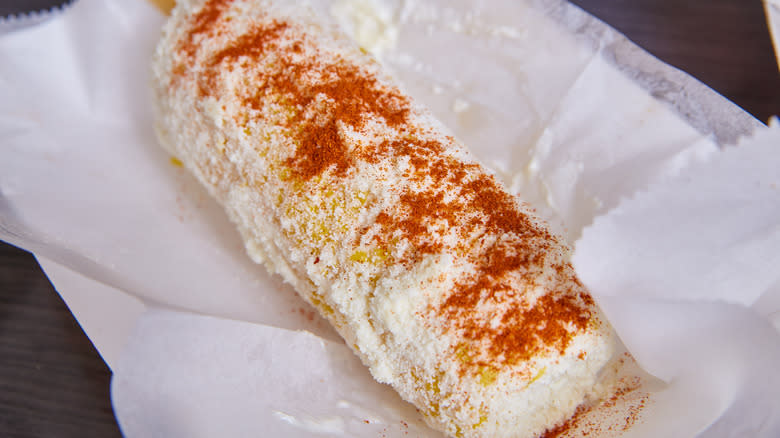The Flavorful Difference Between Elote And Esquites

Corn is one of the most important staple crops in the world, a massive industry fueling everything from dinner to biofuel. But while the United States produces more corn than any other country in the world, it's not the country that eats the most. That would be Mexico, where corn is believed to have first been domesticated. And although the vegetable is an integral part of Mexican cuisine in general, there's one corn-based dish that is so iconic it's become a force to be reckoned with globally, too: Mexican street corn, also known as elote (which means "corn on the cob" in Spanish).
But elote isn't the only delivery vehicle for street-based corn; there's another very similar dish with a similar-sounding name. Esquites, sometimes referred to as Mexican street corn salad, is a lot like elote in most ways. There are a few potential differences in how they can be prepared, but perhaps the most significant distinction is how they're served. While elote is a handheld food, esquites feature the kernels and are eaten with a spoon or fork. These serving methods also affect what kinds of seasonings can be added to each dish.
Read more: 12 Vegetables And Fruits That Used To Look Very Different
Elote And Esquites Are Similar Yet Unique

Elote (traditionally made with white corn rather than the yellow corn more familiar to those farther north in the Americas) is typically cooked over an open flame, most commonly grilled but sometimes boiled. Another essential for the dish is the toppings -- though which toppings depends on where you're getting it (not to mention your own personal preference). Much like how hot dogs can be adorned with any number of extras, elote is a highly customizable street food that typically involves toppings such as lime juice, chile powder, mayonnaise or crema, cheeses like queso fresco and cotija, cilantro, and more. It's then served directly on the cob (and often skewered with a stick for easy handling).
Esquites, by contrast, is served in a cup. Flavor-wise, the two can be very similar, but esquites allow for a bit more experimentation since there's no cob to contend with. While the corn can simply be grilled or boiled and then cut from the cob, some versions opt for simmering the kernels in a pot with flavorful additions like jalapeño and epazote, a leafy, licorice-like plant native to Mexico that chef Pati Jinich calls, "one of the most unique-tasting herbs ever" due to its "very deep and intense," almost medicinal flavor. While esquites and elote are often topped similarly, the former is sometimes found garnished with ingredients elote could never support, such as shrimp, bone marrow, and chicken feet.
Elote Doesn't Have Much Of An Origin Story, But Esquites Do

Another noteworthy difference between esquites and elote appears to be their origins. With elote, there's no apocryphal origin story involved like there is for potato chips. It is believed to have developed out of the Aztec and Mayan practice of cooking corn over an open flame.
Esquites, by contrast, actually do have a tale about their conception. The word itself comes from the Nahuatl word Ízquitl, which translates to "toasted corn." And according to folklore, esquites were first created by Tlazocihuapilli, who is thought to be the only matriarch in the history of the indigenous Xochimilca people of what is now Mexico City. (Tlazocihuapilli is also said to have created the first tamale leaf wrappers.)
Whoever created elote and esquites, we owe them a great debt. Modern society just wouldn't be the same without two of the most delicious corn-based street foods in the world.
Read the original article on Daily Meal.

